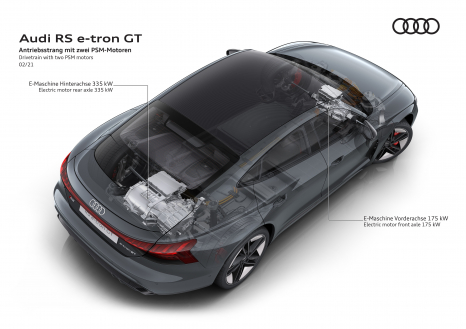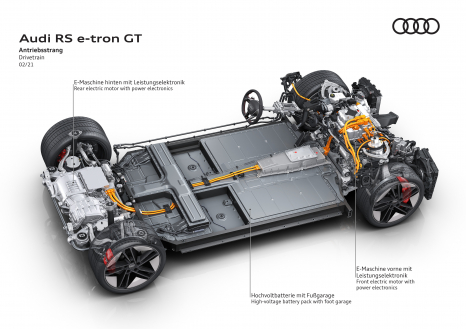Audi RS e-tron GT – Drive concept
The purely electric gran turismo from Audi offers dynamic performance in both engine versions: The e-tron GT quattro (combined electric power consumption in kWh/100 km (62.1 mi)*: 19.6– 18.8 (NEDC), combined CO2 emissions in g/km (g/mi)*: 0) accelerates from zero to 100 km/h (62.1 mph) in 4.1 seconds, while the RS model takes 3.3 seconds (in boost mode in each case). The top speed is 245 km/h (152.2 mph) and 250 km/h (155.3 mph) (governed), respectively.
In the e-tron GT quattro, the front electric motor outputs 175 kW (238 PS), and the rear motor outputs 320 kW (435 PS). Both electric motors keep reserves available for extreme driving situations, which is why the sum of their individual outputs exceeds the drive’s total output of 350 kW (476 PS) considerably. Up to 390 kW (530 PS) are available for approx. 2.5 seconds in boost mode via launch control. The total torque is 630 Nm (464.7 lb-ft), in boost mode 640 Nm (472.0 lb-ft). In the RS e-tron GT, the electric motor at the front axle also outputs 175 kW (238 PS), while the motor in the rear outputs 335 kW (456 PS). The total output is 440 kW (598 PS), and the total torque is 830 Nm (612.2 lb-ft). In boost mode, the output briefly increases to 475 kW (646 PS).
The PSM motors (permanently excited synchronous motors) in the e-tron GT work with great efficiency. The electric motor, its power electronics, and the transmission form a compact block on both axles. The rear electric motor transfers its torques to a two-speed transmission. The close-ratio first gear ensures spirited acceleration right from the start, if the driver so desires. If they choose not to use first gear, the e-tron GT moves off in second gear. Generally speaking, the long-ratio second gear improves efficiency and also provides large amounts of reserve power.
* Information on electric power consumption and CO2 emission figures given in ranges depend on the equipment selected for the vehicle.
02/2021

